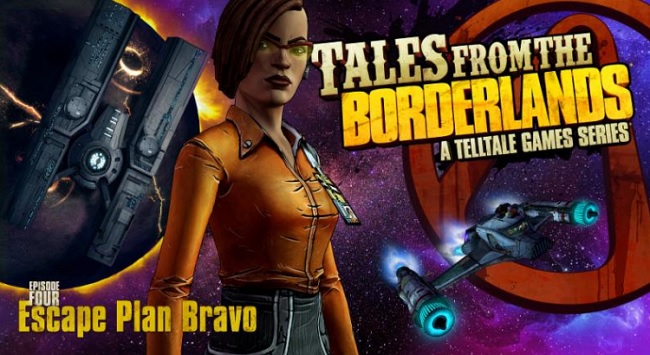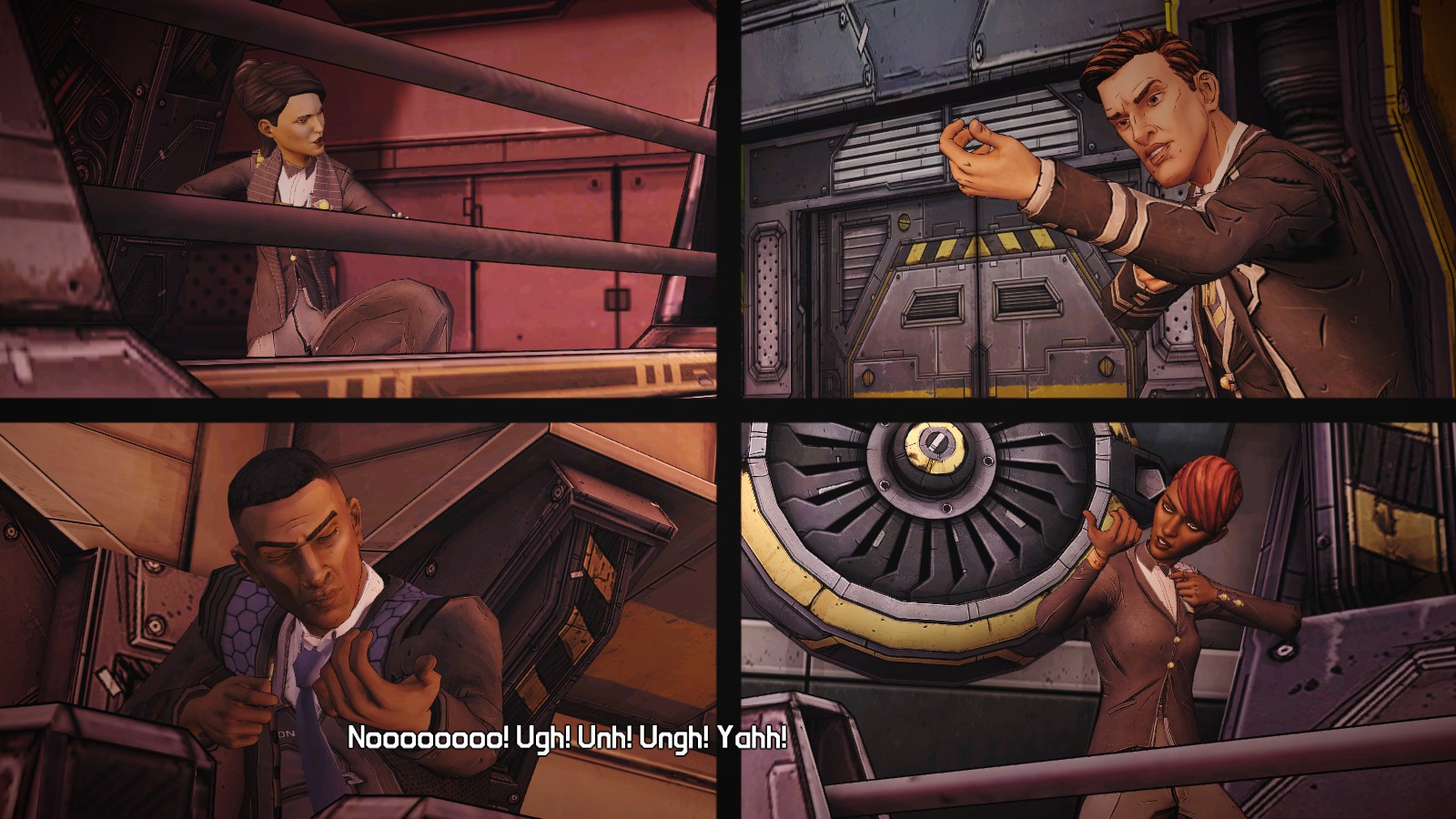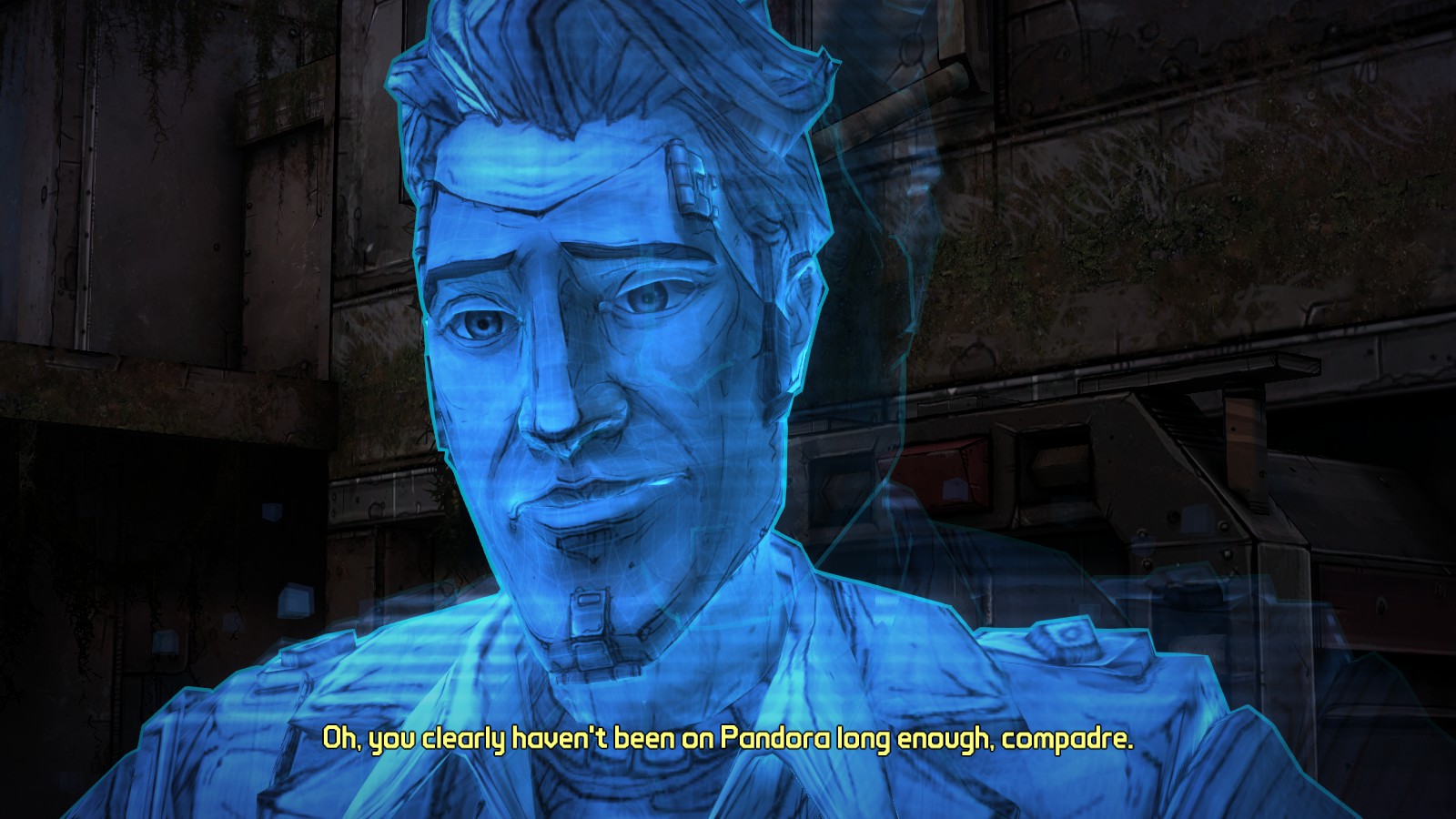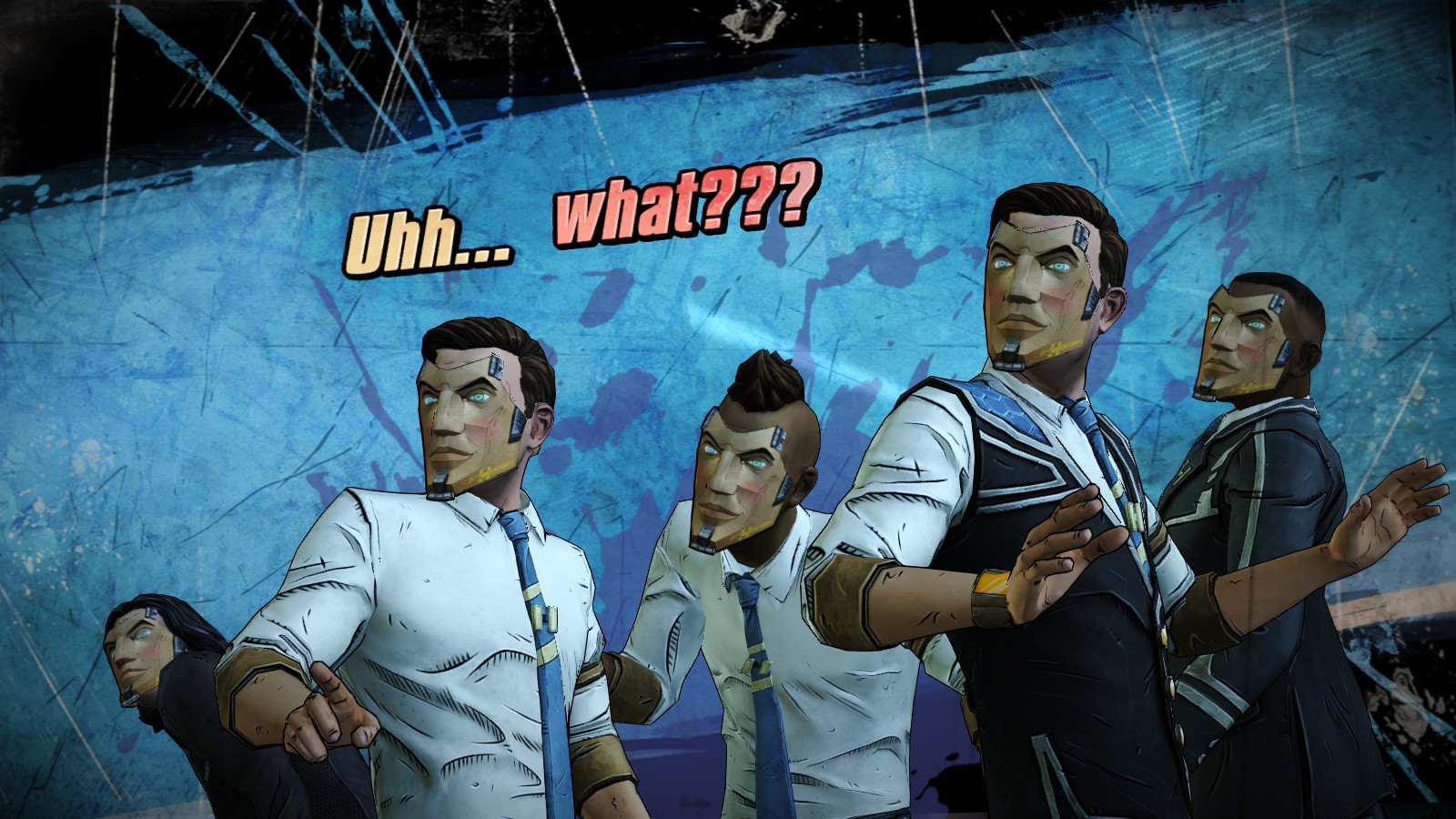
Mmmmmmmmmm, this is what I’ve been waiting for – the heart-string twanging feels that Telltale are known for delivering in The Walking Dead and The Wolf Among Us. (Maybe also in Game of Thrones, but I couldn’t care less about that.) It was something that was missing up to this point, a certain dramatic gravitas to the game’s events that resonate with the player and stir up genuine emotion. Escape Plan Bravo makes up for that in spades, there’s been a lot of improvement in some of my biggest complaint areas about the story from the previous episodes. The same can’t be said with respect to the “gameplay” elements; there’s still certainly less of it though Telltale have tried some experimentation with what players are actually doing. Just a little. Also, no bugs this time!

“That’s awesome maaaan! Y’all know ya should’ve been doin’ that from the start though, right?”
There’s been something missing from the Tales From the Borderlands (TftB) story up to this point, a certain je ne sais quois that Telltale games usually carry which has been decidedly lacking. It’s because the usual approach that Telltale has for adapting an interactive drama from an existing franchise doesn’t work for Borderlands’ story pacing. The problem isn’t that the story hasn’t been good – there’ve been bumpy moments, but the overall quality has been fine thus far. I just haven’t cared about anything very much until now, and that’s somewhat jarring for a game that is supposed to be all about immersing the player in its story. The problem is that Telltale are trying to use Borderlands style characters, in the action-oriented Borderlands universe, with a story pacing that doesn’t match.
First, we have to look at how Borderlands’ story works, which is totally opposite to how Telltale interactive dramas unfold. Borderlands has a smattering of story that gets spread throughout a slew of action sequences, much of it designed to be listened to while you’re shooting’n’looting. It’s why the bulk of Borderlands’ dialogue is actually in small chunks, provided in the form of ECHO recordings. The few times that you do need to stay in one place and listen to someone, you’re also usually required to do a few things at the same time. The weakest moments of the games are the few times you’re just standing around for ages and doing nothing but listening to dialogue. The games are very action-oriented, and excessive dialogue or written logs are a distraction from the core part of the game.

NEVER STOP THE KILLING! NEVER!
This is never an issue, however, since the stories of these games are also entirely designed around shooting’n’looting and endears its characters toward you when they encourage that core concept. You build a connection to your own character as you learn their nuances and abilities, becoming better at controlling them and by extension becoming better at the game. This existence and purpose automatically puts you at odds with the villains in each of the games, and the story progresses as a direct result of your actions. In TftB, there is no similar action for players to be immersed in while the story happens around them. Indeed, as I’ve said in previous entries for this series, TftB’s action can often be quite distracting from what the story is trying to achieve.
While using cameos of existing Borderlands characters to connect TftB to the larger Borderlands universe, the game largely relies on a cast of entirely new characters. New characters mean that you have to build new emotional connections with those characters for their actions to mean something to you. Borderlands 1, 2 and Pre-Sequel accomplish this using the method above but Telltale games are very dialogue, and character interaction focused. When the immersing action of the Borderlands games gets boiled down to QTE’s that disrupt the players focus on the story in this Telltale game, it creates a dissonance between the two. Not sure what I’m talking about? Let’s take a look at the previous episode, Catch A Ride, for some examples of what I mean.

“Strap in, kids, let ol’ Handsome Jack explain it to ya.”
Rhys’ ECHO Eye seemed like a cool idea at first; it’s even shown some potential during gameplay elements (though I’ll get to that later.) The scanning function that allows you to see dialogue read-outs describing the environment around you is neat, but it doesn’t tie directly into the gameplay. You can stop and read through each one, which usually offers some rewarding additional world information, but doing so doesn’t offer any gameplay reward. When it does get used as a gameplay mechanic, it often equates to “click the thing to make stuff happen;” there’s no skill required or involved. Jack’s little additions to these in these last two episodes about how boring the activity can be are correct: It’s the antithesis of the source material.
When the action does ramp up, awesome moments like “controlling a posse of floating Atlas death-bots to kill a bunch of bandits” are reduced to “click the guys to make them die instantly.” The control switches back to Rhys immediately after that moment, and when I say “control switches back,” I mean get ready for more QTE’s. What’s more is that there’s little to no consequence for simply not responding to these QTE’s at all. I’ve replayed some of these episodes a few times knowing that they’re coming, being ready and prepared for them, and there’s virtually no difference between success or failure. Things just carry on, and this mechanic might as well not be here because it certainly isn’t fun. This kind of gameplay only offers the same level of engagement as walking around and scanning objects. It takes the fun out of shooting people in the face, and that’s… That’s just wrong.

At least characters aren’t just wildly fly off the screen mid-sentence again.
It seems the solution so far has been to include less action overall for these past two episodes, which only really results in the occasionally jarring prompt to slap at your keyboard. Escape Plan Bravo at least made a small effort to change up some of the hacking sequences this episode. Without giving too much away, Rhys is presented with a virtual wall that prevents him from breaking into a security system and on which the player must rapidly click to remove. Instead of straight up “clicking the thing to do the thing,” you’re “clicking many things in a certain amount of time to do the thing.” It may seem like a minor change but it at least shows they’re experimenting with gameplay design, and that can only be a good thing at this stage. So, by now you’re probably thinking, “Well, damn, this episode sounds like total Skag poop,” and you’d be wrong.
It’s important to know why there have been problems with the series so far in order to understand how this episode got it so right. The previous episode spent a lot of Rhys’ time focusing on his partnership with Handsome Jack, whom I adore even as a ghost, and whether or not Rhys would be a would be a willing participant. Lord knows I was. This episode goes a little bit further, exploring what it is that Rhys (and by extension the player) wants out of this whole journey. There’re some fairly weighty decisions to be made in this episode, and I feel like Telltale truly captured Jack’s dreadful, yet charmingly inspiring influence in respect to that. Where Escape Plan Bravo shines, however, is how it cements these characters into the overall Borderlands canon.

“Trust me, Kiddo, you’re gonna want every part of this insanity.”
My gushing about Handsome Jack aside, Fiona’s side of the story shouldn’t be discounted. While it didn’t progress or expand on her personal story as much as Rhys’ in this episode, her sections touched on some heavy moments with the established Borderlands canon. Very heavy. I’m still reeling from the events of this episode, and I’m wondering what her impact will be on the rest of the Borderlands story. Catch A Ride already revealed that Vallory knows the Crimson Raiders and Athena’s departure from TftB’s story ties in nicely with Pre-Sequel’s intro cinematic. In this episode especially, Rhys’ story might be significant later down the line (and it will be, just sayin’) but the impact of Fiona’s is immediate and apparent to the Borderlands canon. It’s kind of awesome, and it hurts so good.
 Better story development
Better story development
 Better balance in pacing
Better balance in pacing
 HNNNGGGG TELLTALE Y U DO DIS?
HNNNGGGG TELLTALE Y U DO DIS?
 Still bogged down in QTE’s
Still bogged down in QTE’s
 Gameplay isn’t engaging enough
Gameplay isn’t engaging enough
 Seriously, TTG, fix it or drop it
Seriously, TTG, fix it or drop it
Aside from the confirmation that the glitching character models were an unfortunate one-off, there’s not much to add about Tales from the Borderlands’ audio/visual. The level of presentation has been consistently high throughout the series and, whatever my misgivings about the story, it nails Borderlands’ style. “Misgivings” may also not be entirely the right word; I’ve learned to love the characters, and the story has all the right elements. It’s just that it hasn’t felt like a Borderlands game. It hasn’t even felt like a Telltale interactive drama since it keeps trying to force action over better storytelling, which I know they’re capable of providing. Telltale seem to be finding a nice equilibrium between the two, however, and I’m hanging out for the final episode.
(Just as an aside, I’m secretly hoping that Vaughn turns into a Psycho Sort-Of-Midget.)
EDITOR NOTE: this game was purchased at retail by the writer and reviewed on PC across 4 hours of gameplay. Please also understand that in an effort to be fair, we will not score an episodic game until the season is complete.











